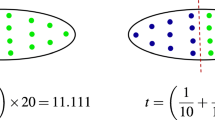Abstract
Hypergraph partitioning has been considered as a promising method to address the challenges of high-dimensional clustering. With objects modeled as vertices and the relationship among objects captured by the hyperedges, the goal of graph partitioning is to minimize the edge cut. Therefore, the definition of hyperedges is vital to the clustering performance. While several definitions of hyperedges have been proposed, a systematic understanding of desired characteristics of hyperedges is still missing. To that end, in this paper, we first provide a unified clique perspective of the definition of hyperedges, which serves as a guide to define hyperedges. With this perspective, based on the concepts of shared (reverse) nearest neighbors, we propose two new types of clique hyperedges and analyze their properties regarding purity and size issues. Finally, we present an extensive evaluation using real-world document datasets. The experimental results show that, with shared (reverse) nearest neighbor-based hyperedges, the clustering performance can be improved significantly in terms of various external validation measures without the need for fine tuning of parameters.














Similar content being viewed by others
References
Agrawal R, Imielinski T, Swami AN (1993) Mining association rules between sets of items in large databases. In: Proceedings of the ACM SIGMOD conference on management of data, pp 207–216
Arya S, Mount DM, Netanyahu NS, Silverman R, Wu AY (1998) An optimal algorithm for approximate nearest neighbor searching fixed dimensions. J ACM 45(6):891–923
Baeza-Yates R, Ribeiro-Neto B (1999) Modern information retrieval. Addison-Wesley, Reading
Bandyopadhyay S, Maulik U (2002) An evolutionary technique based on k-means algorithm for optimal clustering in \(R^N\). Inf Sci 146(1–4):221–237
Cheeseman P, Stutz J (1996) Bayesian classification (AutoClass): theory and results. In: Advances in knowledge discovery and data mining, pp 153–180
Chen C, Tseng F, Liang T (2011) An integration of fuzzy association rules and wordnet for document clustering. Knowl Inf Syst 28(3):687–708
Ertoz L, Steinbach M, Kumar V (2003) Finding clusters of different sizes, shapes, and densities in noisy, high dimensional data. In: Proceedings of the 3rd SIAM international conference on data mining, pp 47–58
Fodeh S, Punch B, Tan P (2011) On ontology-driven document clustering using core semantic features. Knowl Inf Syst 28(2):395–421
France SL, Carroll JD, Xiong H (2012) Distance metrics for high dimensional nearest neighborhood recovery: compression and normalization. Inf Sci 184(1):92–110
Han E-H, Karypis G, Kumar V, Mobasher B (1998) Hypergraph based clustering in high-dimensional data sets: a summary of results. IEEE Data Eng Bull 21(1):15–22
Hu T, Sung SY (2006) Finding centroid clusterings with entropy-based criteria. Knowl Inf Syst 10(4):505–514
Hu T, Sung SY, Xiong H, Fu Q (2008) Discovery of maximum length frequent itemsets. Inf Sci 178(1):69–87
Hu T, Tan CL, Tang Y, Sung SY, Xiong H, Qu C (2008) Co-clustering bipartite with pattern preservation for topic extraction. Int J Artif Intell Tools 17(1):87–107
Huang Y, Xiong H, Wu W, Deng P, Zhang Z (2007) Mining maximal hyperclique pattern: a hybrid search strategy. Inf Sci 177(3):703–721
Jain AK, Murty MN, Flynn PJ (1999) Data clustering: a review. ACM Comput Surveys 31(3):264–323
Kalogeratos A, Likas A (2012) Text document clustering using global term context vectors. Knowl Inf Syst 31(3):455–474
Karypis G (2003) CLUTO—software for clustering high-dimensional datasets. http://glaros.dtc.umn.edu/gkhome/views/cluto
Karypis G, Aggarwal R, Kumar V, Shekhar S (1997) Multilevel hypergraph partitioning: applications in VLSI domain. In: Proceedings of the 34th conference on design automation, pp 526–529
Korn F, Muthukrishnan S (2000) Influence sets based on reverse nearest neighbor queries. In: Proceedings of the 2000 ACM SIGMOD international conference on management of data, pp 201–212
Leung C, Chan S, Chung F (2006) A collaborative filtering framework based on fuzzy association rules and multiple-level similarity. Knowl Inf Syst 10(3):357–381
Lin TY, Chiang I-J (2005) A simplicial complex, a hypergraph, structure in the latent semantic space of document clustering. Int J Approx Reason 40(1–2):55–80
Liu C, Hu T, Ge Y, Xiong H (2012) Which distance metric is right: An evolutionary k-means view. In: Proceedings of the 12th SIAM international conference on data mining, pp 907–918
Ni X, Quan X, Lu Z, Liu W, Hua B (2011) Short text clustering by finding core terms. Knowl Inf Syst 27(3):345–365
Ozdal MM, Aykanat C (2004) Hypergraph models and algorithms for data-pattern-based clustering. Data Min Knowl Discov 9(1):29–57
Rajpathak D, Chougule R, Bandyopadhyay P (2012) A domain-specific decision support system for knowledge discovery using association and text mining. Knowl Inf Syst 31(3):405–432
Rennie JD, Shih L, Teevan J, Karger DR (2003) Tackling the poor assumptions of naive bayes text classifiers. In: Proceedings of the 20th international conference on machine learning, pp 616–623
Steinbach M, Karypis G, Kumar V (2000) A comparison of document clustering techniques. In: KDD workshop on text mining
Vadapalli S, Valluri SR, Karlapalem K (2006) A simple yet effective data clustering algorithm. In: Proceedings of the 6th IEEE international conference on data mining, pp 1108–1112
Xia C, Hsu W, Lee ML, Ooi BC (2006) BORDER: Efficient computation of boundary points. IEEE Trans Knowl Data Eng 18(3):289–303
Xiong H, Tan P-N, Kumar V (2006) Hyperclique pattern discovery. Data Min Knowl Discov 13(2):219–242
Zhao Y, Karypis G (2004) Empirical and theoretical comparisons of selected criterion functions for document clustering. Mach Learn 55(3):311–331
Zhao Y, Karypis G (2005) Hierarchical clustering algorithms for document datasets. Data Min Knowl Discov 10(2):141–168
Acknowledgments
We would like to thank the editor and reviewers for their valuable comments. This work was supported by NSFC(61100136,61272067,70890082,71028002), GDNSF(S2012030006242) and NSF(CCF-1018151).
Author information
Authors and Affiliations
Corresponding author
Rights and permissions
About this article
Cite this article
Hu, T., Liu, C., Tang, Y. et al. High-dimensional clustering: a clique-based hypergraph partitioning framework. Knowl Inf Syst 39, 61–88 (2014). https://doi.org/10.1007/s10115-012-0609-3
Received:
Revised:
Accepted:
Published:
Issue Date:
DOI: https://doi.org/10.1007/s10115-012-0609-3




